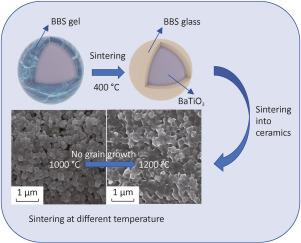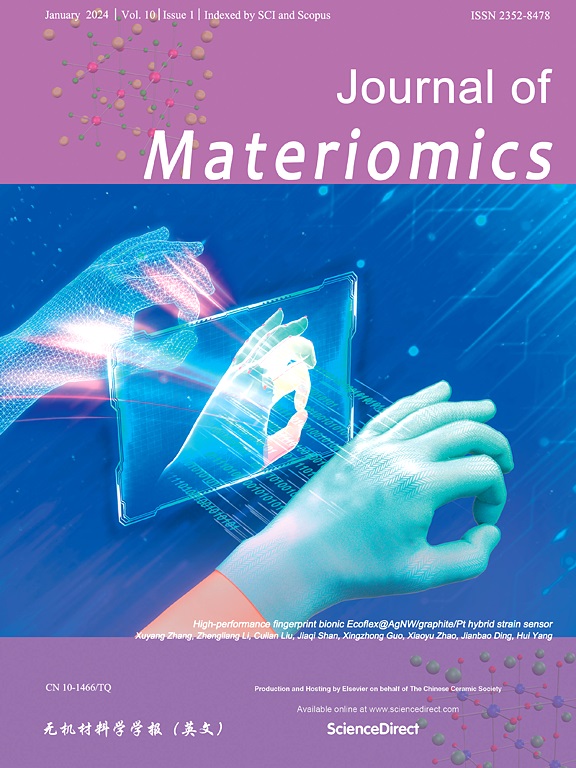在三氧化钡钛上设计玻璃纳米壳,以抑制烧结过程中纳米晶体的生长,从而制造出细粒度电介质陶瓷
IF 8.4
1区 材料科学
Q1 CHEMISTRY, PHYSICAL
引用次数: 0
摘要
钛酸钡(BaTiO3,BT)是多层陶瓷电容器(MLCC)行业的关键介电材料之一。为满足多层陶瓷电容器微型化和高容量化的发展趋势,需要具有纳米粒度的烧结陶瓷。在此,我们展示了利用溶胶-凝胶玻璃封装策略抑制烧结过程中纳米晶体生长的细晶粒 BaTiO3 陶瓷的可控制备方法。研究发现,平均横向粒径为 70 nm 和 200 nm(BT70 和 BT200)的 BaTiO3 纳米晶体可以包覆在 Bi2O3-B2O3-SiO2 (BBS)玻璃壳上,形成核壳结构。在不同的封装量和烧结温度下,钛酸钡陶瓷都能获得精细的晶体。然而,比表面积较大、反应活性较高、结晶度较低的 BT70 在溶胶-凝胶过程中更容易发生水解,导致烧结后形成新相 Ba2TiSi2O8,从而对烧结行为和介电特性产生不利影响。另一方面,BT200 在溶胶-凝胶过程中水解的可能性较低,导致烧结后形成单相陶瓷。在 1100 °C 下烧结涂有 5%(质量分数)BBS 的 BT200 时,得到了致密的 BaTiO3 陶瓷,其介电常数为 1194.23,在室温和 1 kHz 下的损耗为 0.0139。因此,这项工作为 MLCC 应用提供了一种在烧结过程中抑制纳米晶体生长的稳健策略。本文章由计算机程序翻译,如有差异,请以英文原文为准。

Designing a glass nanoshell on barium titanium trioxide to suppress nanocrystal growth during sintering for fine-grain dielectric ceramics
Barium titanate (BaTiO3, BT) is one of the key dielectric materials for multilayer ceramic capacitor (MLCC) industry. To meet the development trend of miniaturization and high capacity of MLCC, the sintered ceramic with nanosized grain is required. Herein, we demonstrate a controllable preparation of fine-grain BaTiO3 ceramic by using sol-gel glass encapsulation strategy to suppress the growth of nanocrystal during sintering. It is found that the BaTiO3 nanocrystal with average lateral particle size of 70 nm and 200 nm (BT70 and BT200) can be coated with Bi2O3-B2O3-SiO2 (BBS) glass shell to form core-shell structures. The fine crystal of barium titanate ceramics can be achieved under different encapsulation quantities and sintering temperature. However, BT70, with a larger specific surface area, higher reactivity, and lower crystallinity, was more prone to hydrolyze in the sol-gel process, leading to the formation of a new phase after sintering, Ba2TiSi2O8, which adversely affected both the sintering behavior and dielectric properties. On the other hand, BT200 exhibited lower possibility to hydrolyze in the sol-gel process, resulting in single-phase ceramics after sintering. When the BT200 coated with 5% (in mass) BBS was sintered at 1100 °C, a dense BaTiO3 ceramic were obtained, with dielectric constant of 1194.23 and loss of 0.0139 at room temperature and 1 kHz. Therefore, this work provides a robust strategy for suppressing the nanocrystal growth during sintering for MLCC applications.
求助全文
通过发布文献求助,成功后即可免费获取论文全文。
去求助
来源期刊

Journal of Materiomics
Materials Science-Metals and Alloys
CiteScore
14.30
自引率
6.40%
发文量
331
审稿时长
37 days
期刊介绍:
The Journal of Materiomics is a peer-reviewed open-access journal that aims to serve as a forum for the continuous dissemination of research within the field of materials science. It particularly emphasizes systematic studies on the relationships between composition, processing, structure, property, and performance of advanced materials. The journal is supported by the Chinese Ceramic Society and is indexed in SCIE and Scopus. It is commonly referred to as J Materiomics.
 求助内容:
求助内容: 应助结果提醒方式:
应助结果提醒方式:


